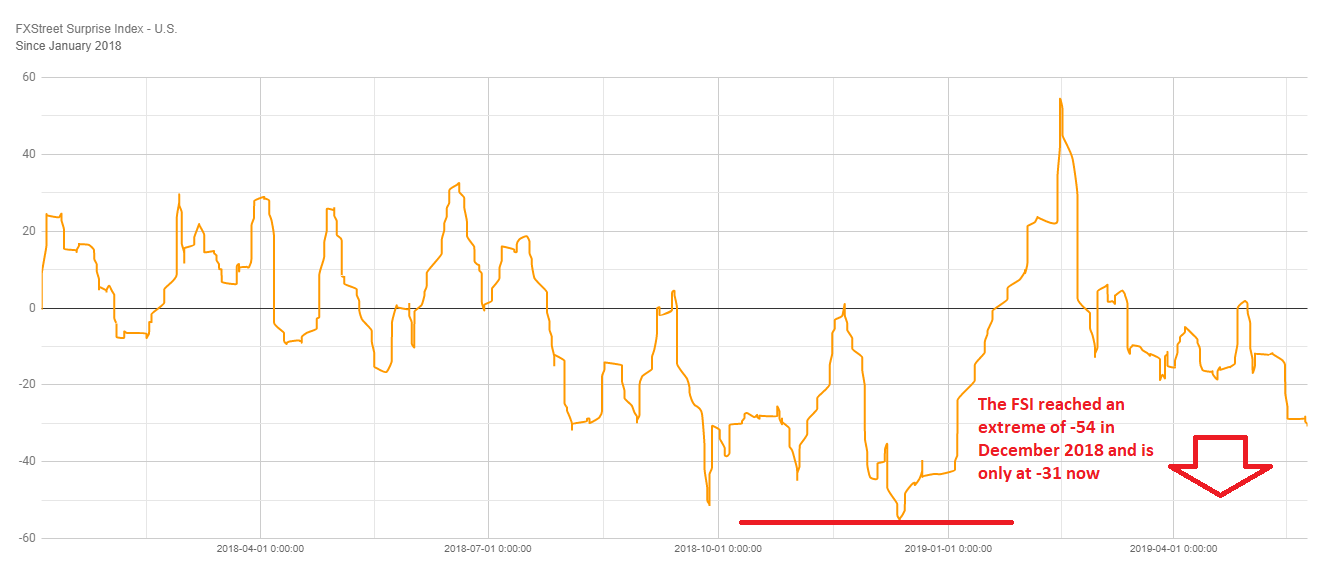The previous piece analyzing the FXStreet Surprise Index about the Non-Farm Payrolls has correctly predicted the bitter disappointment. The US economy gained only 75K jobs in May – and the USD tanked.
Will the Index hit the nail on its head again?
This edition focuses on the Federal Reserve second mandate – price stability. The FXStreet Surprise Index has been updated with the Non-Farm Payrolls figure as well as others.
The general broader picture has remained unchanged. The Index continues trending lower. It now stands at -222 against -221 ahead of the jobs report showing an accumulation of negative surprises that are also growing in magnitude. The trend has been continuous since the indicator broke below -202 which was a double-bottom on the chart.
Breaking below the double bottom opens the door to substantial falls.

Now, no trend lasts forever and conditions may reach extreme levels. When a currency falls too far, it becomes oversold – reflected in an extremely low Relative Strength Index (RSI) – and this results in a bounce.
Similar behavior applies to surprises on economic indicators. Negative surprises come against economists’ expectations. After a series of significant misses, these experts adapt their projections towards the next events and surprises may then turn positive.
Has the FXStreet Surprise Index reached extreme levels? Or is set for a temporary correction?
No.

Zooming into data from early 2018 onwards, we can see that the Index has hit an extreme of -54 on December 13th, 2018 – when stock markets were crashing. From that point, it moved up and recovered, exiting oversold conditions. It went as high as +54 on February 12th before gradually slipping lower.
And it has not hit an extreme – at least not yet. According to this view, we are now at -31. There is still some room to go before we can expect surprises to turn positive.
Why weak inflation may push the dollar lower
The next top-tier indicator is the consumer price index release for May due on Wednesday, June 12th. Core CPI is set to rise by 2.1% year on year – repeating last month’s figure – while accelerating from 0.1% to 0.2% on a monthly basis. According to an analysis of the FXStreet Surprise Index above, there is room for a downside surprise.
The release comes exactly one week ahead of the Federal Reserve’s critical decision. The Fed is expected to leave the interest rate unchanged but may signal future rate cuts via its new projections – the dot plot.
A combination of disappointing employment and weak inflation may prompt a substantial downgrade in rate projections from zero cuts in 2019 to as much as two – aligning the Fed with market expectations. A considerably low inflation rate may trigger a cut as early as July.
The US dollar has already suffered from the downgrade in expectations but a sluggish CPI remains the missing piece in the puzzle. Inflation has become even more important as President Donald Trump reiterates that it is “very low.” – and that will be tested in the CPI release.
Falling inflation is not priced in. A negative surprise can, therefore, kick the greenback lower.
About the FXStreet Surprise Index
FXStreet Surprise Index quantifies, in terms of standard deviations of data surprises (original releases vs. survey median), the extent to which economic indicators exceed or fall short of consensus estimates.
Economic reports with better- or worse-than-expected news are assigned a positive or negative deviation value, while reports meeting expectations get a 0 deviation value. Adding up the values of the deviations, and you get an initial series showing how economic data are progressing relative to the consensus forecasts of market economists. The deviation formula employs a ratio function to replicate behavioral anchors of market participants.
Preserving the properties of these underlying series, the index finally shows the detrended momentum of the surprises in relation to previous weeks.
Surprise Indexes are constructed for the United States, Euro Area, Germany, United Kingdom, Canada, Japan, Australia, and New Zealand.
Get the 5 most predictable currency pairs
US inflation may send the USD down
